What’s the Buzz? Tracking Pollinators and Their Favorite Plants in the Danforth Center Prairie
Pollinator Week invites us to appreciate the often-overlooked heroes that support Earth’s ecosystems and many of the agricultural systems that feed us. At the Danforth Center, we share our space with these essential insects every day; just outside our laboratories and greenhouses, our six-acre swath of reconstructed prairie is teeming with pollinators. It’s a consistent reminder of the importance of supporting native ecosystems, even in urban spaces.
Surveying a Pollinator Playground
For the past several years, Senior Research Scientist & Principal Investigator Bala P. Venkata, PhD, and his team of plant scientists and entomologists have regularly scouted the prairie to learn more about the insects that visit. Their goal is to document the diversity of insect pollinators and explore how restoring native plants in urban areas aids biodiversity preservation.
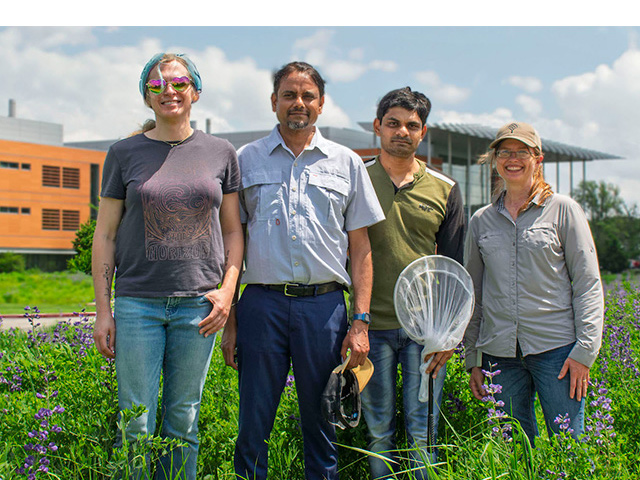
This year’s scouting team, from left to right: Research Technician Rabia Polzin, Senior Research Scientist & Principal Investigator Bala P. Venkata, Research Scientist Sharath Gaddelapati, and Research Technician Crystal Camp.
“Insect pollinators are essential for food production, but their populations are declining,” Venkata said. “Restoring native perennial plants in urban areas, such as the Danforth Center prairie, is increasingly important for combating the loss of pollinator habitats.”
“Without flora diversity we lose the diversity of insects; amphibians and reptiles begin to decline; and a ripple effect moves up the food chain, ultimately impacting humans,” added Research Technician Crystal Camp. “We need these ecosystems to sustain life.”
“Areas like this can serve as both homes for native insects and other animals to live and breed,” explained Research Technician Rabia Polzin. “They can act as way stations for migratory birds and butterflies as they travel through the continent en route to seasonal breeding grounds”
Venkata noted that “repeated observations of various pollinator species at the Danforth Center prairie over several years indicate that its diverse native plants offer essential resources and nesting sites, underscoring the need to restore and preserve urban perennial habitats.”
This year’s scouting efforts only strengthen the case that even a small area like our prairie can make a big impact on local biodiversity, offering food and shelter to a wide range of pollinators.
13 Prairie Plants that Pollinators Loved
Want to get involved in supporting these all-important insects? Consider planting some pollinator favorites of your own. Below is a guide to 13 species of flora that our scientists observed attracting pollinators:
Amsonia illustris (Shining Blue Star or Ozark Blue Star)
Amsonia illustis is native to Missouri and is a spring bloomer that is rich in nectar, providing food for pollinators when other food sources are scarce. Many species of pollinators are attracted to this plant. A. illustris is an erect, clump-forming plant that has small, star-like, light blue to white flowers that grow in pyramidal clusters in mid to late spring. The leaves are shiny green, leathery, and narrow. The foliage remains attractive throughout the summer. Large, pea-shaped seed pods form in the summer and mature to a shade of brown. A. illustris also produces a milky latex sap when cut or torn as a defense mechanism from herbivory.
Asclepias syriaca (Common Milkweed)
This Missouri native perennial has slightly drooping clusters of pink flowers atop stout, upright stems with broad-oblong, light green leaves. It is an excellent source of nectar for many butterflies and other pollinators. It is also a critical food source for monarch larvae and provides habitat throughout the monarch’s life cycle. It blooms late spring through summer.
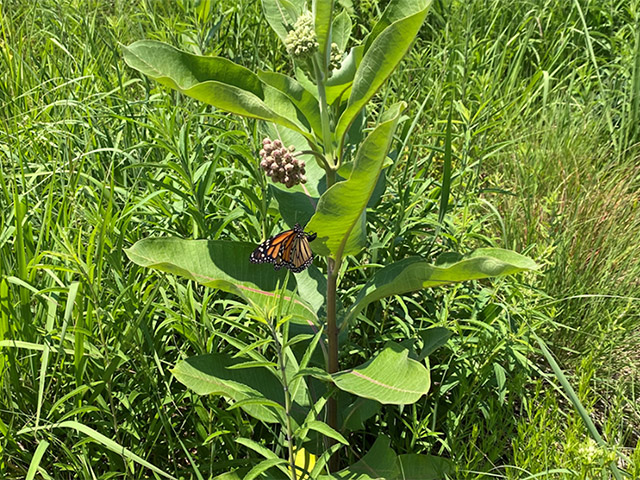
A monarch butterfly (Danaus plexippus) lands on a common milkweed (Asclepias syriaca).
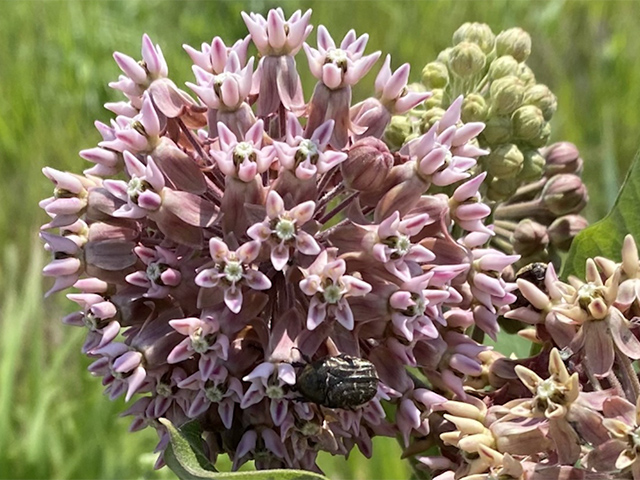
A dark flower scarab (Euphoria sepulcralis) crawls on the flower of a common milkweed (Asclepias syriaca).
Asclepias tuberosa (Butterfly Milkweed)
This Missouri native perennial produces bright orange flowers atop upright, hairy stems. The leaves are narrow and lance shaped. Blooming late spring through summer, this perennial is an excellent source of nectar and pollen, attracting an array of pollinators—including hummingbirds. It is a host plant for monarchs and attracts many beneficial insects that help control crop pests.
Baptisia australis (Blue false indigo)
This upright perennial is native to the eastern United States and is often one of the first plants to flower in the Danforth Center prairie. It typically grows three to four feet tall and features purple, lupine-like flowers atop flower spikes that tower above the clover-like foliage. After blooming, its flowers give way to large, black seed pods. It grows best in full sun and was very popular among the pollinators during our scientists’ observations.
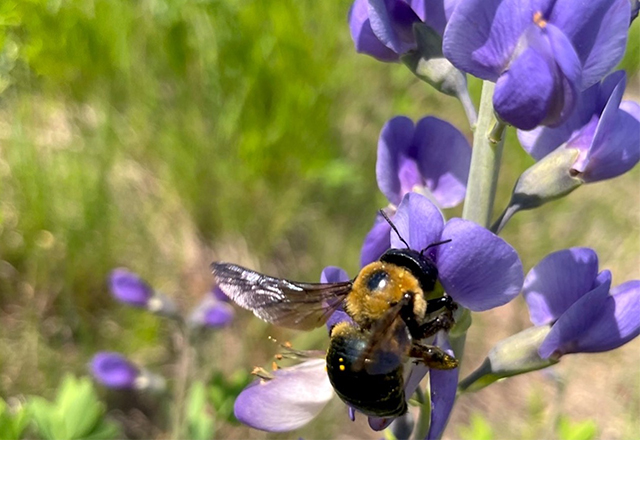
An eastern carpenter bee (Xylocopa virginica) lands on flowering blue false indigo (Baptisia australis).
Coreopsis lanceolata (Lanceleaf Coreopsis)
This Missouri native blooms late spring through early summer. Deadheading can often prolong the blooming period. A few microclimates around the prairie allowed for some of these to bloom early this year, in the first half of May, providing some lucky bees with a big score of pollen at a time when other food sources are scarce and competition is high. Coreopsis lanceolata provides a nectar and pollen for a wide range of pollinators and is a host plant for some lepidoptera species. It has clumps of basal foliage of lance shaped leaves that send up slender, erect, stalks. Each stalk produces a single daisy-like, yellow flower. Once the flowers expire the plant produces seed that is a food source for several songbirds.
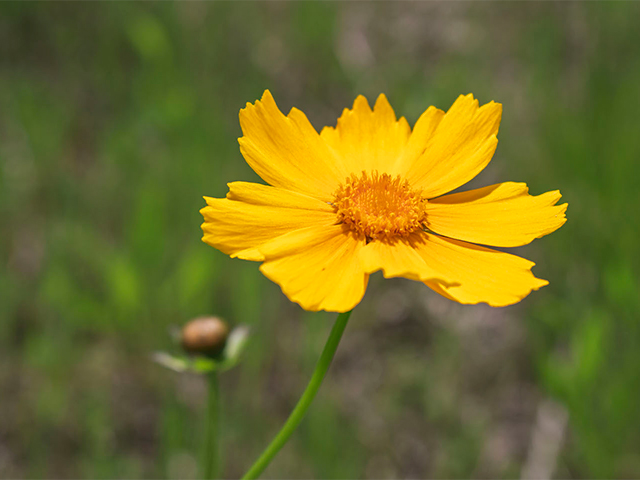
A lanceleaf coreopsis flower blooms in the Danforth Center prairie.
Coreopsis palmata (Prairie Coreopsis or Prairie Tickseed)
Yellow daisy-like flowers with flat yellow centers sit atop upright stems from late spring to midsummer. The leaves grow up the stem and divide into three narrow lance shaped segments that do not protrude into the base of the leaf. This Missouri native perennial provides both nectar and pollen and attracts an array of pollinators. It is a host plant for some Lepidoptera (moth and butterfly) species, and its seeds provide food for songbirds and small mammals.
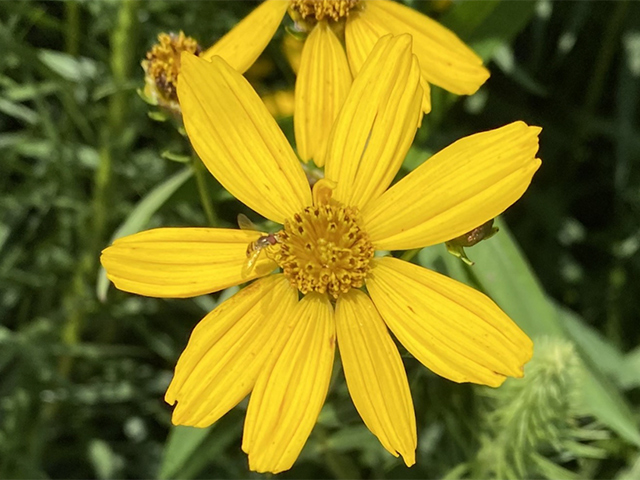
A hover fly visits a coreopsis palmata flower.
Echinacea purpurea (Purple Coneflower)
This herbaceous perennial has showy, daisy-like, purple flowers atop stiff stems with coarse ovate to wide lanceolate dark green leaves. This native perennial blooms from late spring to late summer and attracts a wide variety of pollinators—including hummingbirds—and an array of beneficial insects that help control crop pests. It is a good food source for nectar and pollen. The seed is a food source for many songbirds, especially goldfinches. Echinacea purpurea is also a host plant for some species of bees.
Liatris spicata (Dense Blazing Star)
Terminal spikes of round, deep purple flowerheads sit atop upright, erect, leafy green stalks and tufts of grass-like basal foliage during late spring and summer. This native perennial attracts an array of pollinators including birds. As L. spicata is rich in nectar, is a host plant for some moth species, and the seeds are a food source for some birds.
Monarda fistulosa (Wild Bergamot or Bee Balm)
This native member of the mint family is a clump-forming perennial with lavender-colored, two-lipped, tubular flowers on dense solitary terminal heads atop square stems. Each flower is whorled with showy pink bracts (modified leaves). Monarda provides an abundant source of nectar and pollen for an array of pollinators, including hummingbirds. It is also a host plant for some species of moths and blooms from late spring to mid-summer.
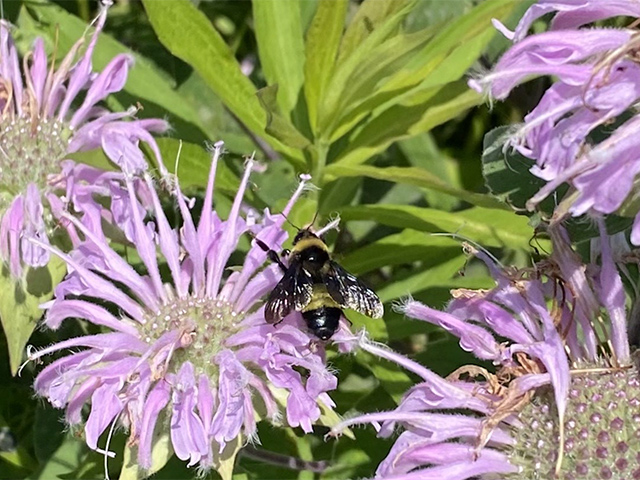
A black and gold bumblebee (Bombus auricomus) pollinates a flowering bee balm (Monarda fistulosa).
Parthenium integrifolium (Wild Quinine)
This clump-forming native perennial has white flowerheads with tiny ray flowers on broad terminal corymbs with rough toothed leaves and large basal foliage. Blooming from late spring to early summer, this plant attracts an array of pollinators, providing them with nectar and pollen. This plant also provides habitat for many species, including the leaf cutter bees as the females will use its leaves in their nests.
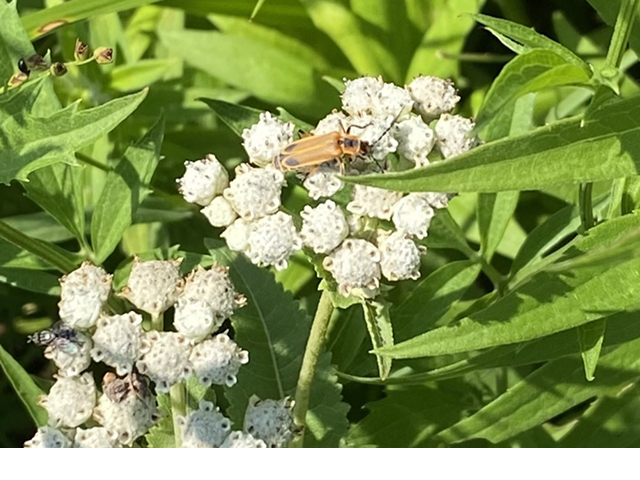
A margined soldier beetle (Chauliognathus marginatus) pollinates a wild quinine (Parthenium integrifolium) plant.
Rudbeckia fulgida (Orange Coneflower)
This native, herbaceous perennial has daisy-like flowers with yellow rays and brownish-purple center disks atop erect stems with oblong to lance shaped green foliage. Blooming from late spring through summer, Rudbeckia attracts an array of pollinators as it provides nectar and pollen, and the seeds are food for many songbirds.
Penstemon digitalis (Foxglove Beardtongue)
Not to be confused with the European foxglove Digitalis purpurea. Penstemon digitalis is a Missouri native perennial that has panicles of two-lipped, white, tubular flowers atop erect stems with lance shaped stem leaves and elliptic basal leaves. Blooming from mid spring to early summer these plants provide nectar and pollen at a critical time when food sources are scarce as it is often blooming when many early spring bloomers are done or finishing up and is finishing its bloom season shortly after the long summer bloomers begin. Penstemon digitalis attracts many pollinators including hummingbirds, long tongue bees, and is a host plant for some species of Lepidoptera.
Nepeta sp. (Catmint)
This non-native perennial provides nectar and pollen throughout the growing season for an array of pollinators. It is also very fragrant.
This plant is not native to the U.S., but it is a common landscaping plant. It is important to note that if you are interested in growing native plants, it is not necessary to grow exclusively native plants; instead, consider incorporating native plantings into existing landscapes among peonies, tulips, bearded iris, and other beloved gardening staples.

A cabbage white (Pieris rapae) moth visits a catmint (Nepeta sp.) plant.
Rebuilding prairie ecosystems is a great way to support the pollinators that support our food systems. This Pollinator Week, take a cue from the Danforth Center’s prairie, even if you start small. It might surprise you to see what a difference you can make just by planting just a small pollinator-friendly flower patch.